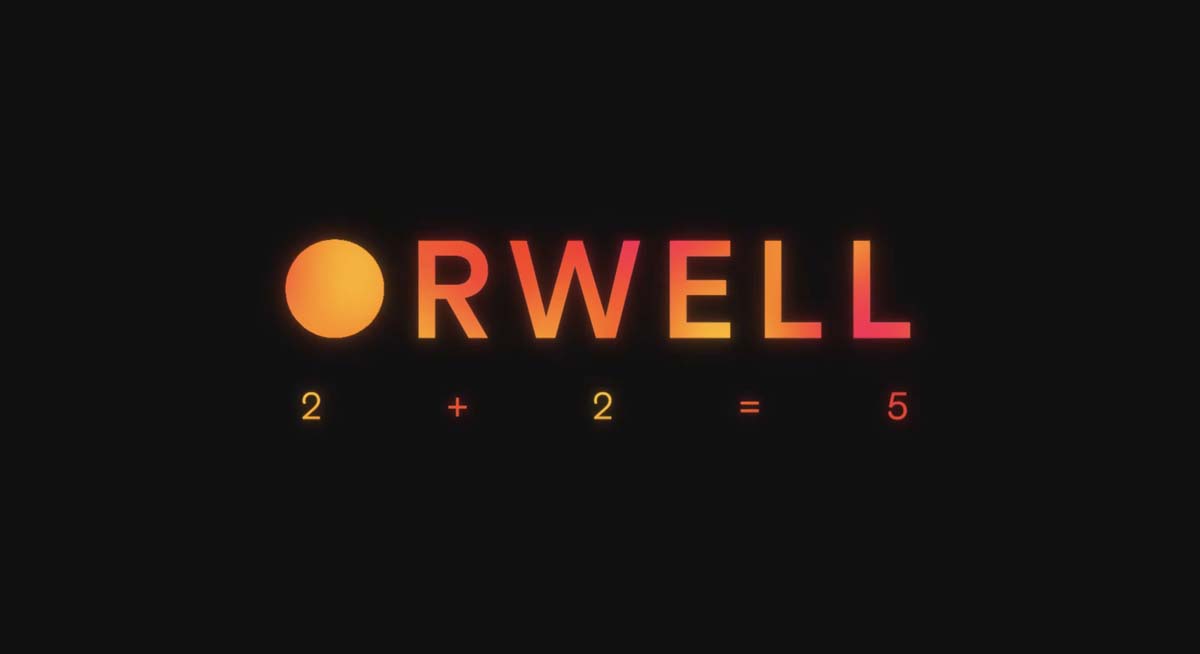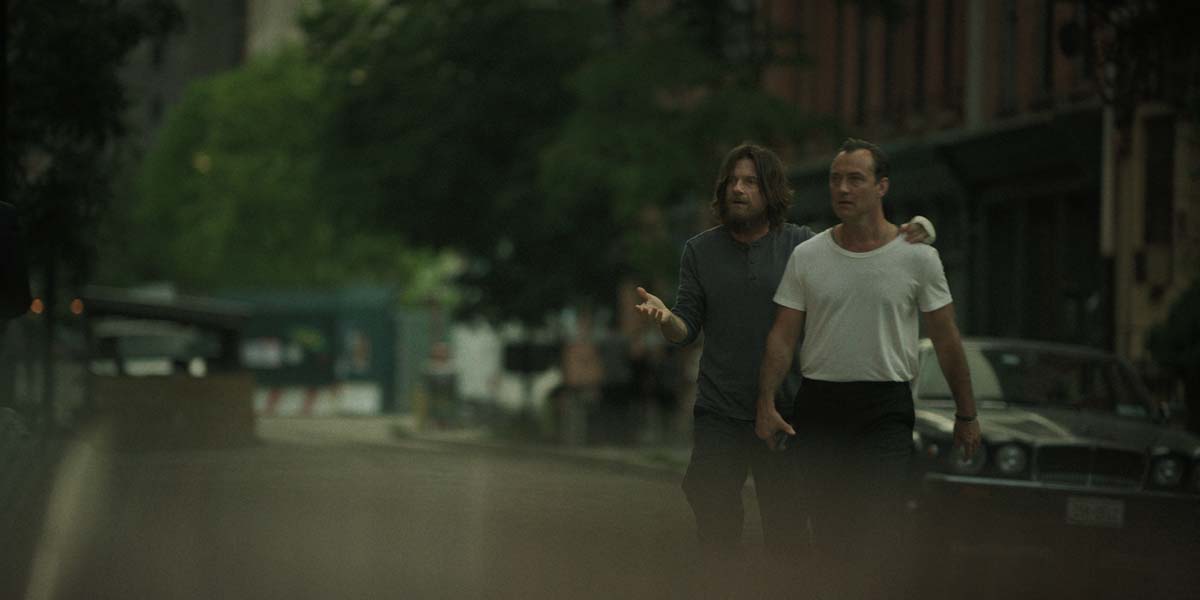Alien Romulus
Oscar-nominated editor Jake Roberts, ACE, discusses the science behind the jump scare, the pacing required to build tension, and how they shot special effects in the cutting room.
Today on Art of the Cut we speak with Jake Roberts, ACE, about editing “Alien Romulus.”
Jake has been on Art of the Cut previously for the films Brooklyn, Hell or High Water, and The Hitman’s Bodyguard. He was also on for the TV series, Devs.
His work on Hell or High Water was nominated for an Independent Spirit Award, an ACE Eddie and an Oscar.
Jake, this is a new director for you, correct?
Yes. I met Fede via Zoom ‘cause I’m based in the UK and he’s based in LA. I think I came across his radar because of my association with Alex Garland and he was a big fan of Alex’s work (Roberts edited the Garland-directed films Civil War and Men and the TV series, Devs). I think he met Alex years ago around about the time of “28 Days Later” (which Garland wrote), with a view to possibly collaborating on something. They had a few conversations, so he was obviously been paying attention to Alex’s work over the years. I wasn’t a particularly obvious choice in terms of genre. I hadn’t done horror films before. “Men” was kind of creepy, but it’s a very different style of film. Fred and I met via Zoom and had a couple of conversations, then I got offered the job, which was really exciting.
We didn’t really meet in person until after the film. We finished shooting and I got to LA for the director’s cut. So it was 15 weeks into the process before we met in the flesh. They shot in Hungary in the same stages that Dune Two had just vacated. Those stages are very well used for productions that need to build sets that take a huge amount of time to build, then need them for a long period of time. It’s by far the most economical place in the world to do that. And the crews are already good. It’s a popular choice for these kind of big sci-fi films. Fortunately for me, I was able to stay in the UK.
Some directors really like you to be physically adjacent to the shoot.
I find - if I’m allowed to - that being far away is better, really. I think the nearer you are, the more influenced you become by the sort of politics of people on the set - like when days have gone well, or when they’ve gone badly. All sorts of things can creep into your perception of the material. Really - in one’s role as an editor - probably the most important thing is to be objective. You are the first audience for this material, so the further you can be from it, I find that it’s healthier.
The DIT in Hungary would transcode the footage and put it online and then it would go to my assistant editors - who were in LA - but because of time change - the end of the shoot day in Hungary would be the beginning of the assistant’s time in LA. The assistants in LA could sync it and make the bins up during their work day, then I’d wake up at my time in the UK and it would all be ready. Our post supervisor - Mark McCoy -said this was the best, most efficient cutting we’d ever had in his career, and he was gonna try and do this with every film ‘cause he basically had a sort of 24 hour rolling cutting room where no one had to work any night shifts. Everyone’s days just stacked up, so it was really efficient and great and no one dropped a beat.
Any special technology that you used to be able to do that?
It’s a proprietary drive from a company in the UK called Salon and it’s multiple terabytes. You plug it in and as the dailies are ingested by your assistants in LA by osmosis. It sort of just drips into my drive system here. It takes a little while, but as long as you’ve got super fast broadband, then you need a few hours to ingest the footage because of the time changes. By the time I would wake up in the morning it was all ready. So it was super efficient.
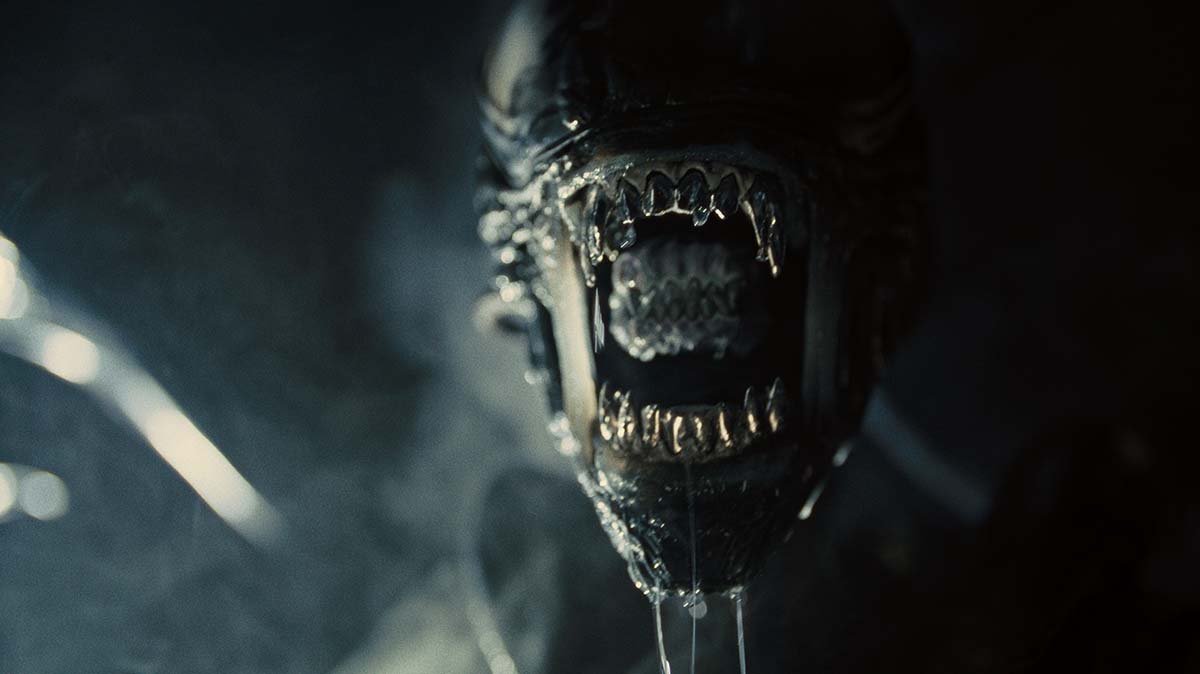
One of the previous times that we talked you mentioned that when you cut a scene together in your editor’s cut, you don’t like to leave in lines that you don’t think should be there: that you will cut out a line that’s in the script. About half the editors I talk to agree with you, and about half say they would never cut out a line that was in the script. Was that something that you needed to work through with Fede or was that different with him?
I would put up my cuts for Fede to watch during the shoot and it was never clear to me whether he was watching them or not. As it transpired: he didn’t. Some directors really find it, throws them off their game. When he spoke to me about the editor’s cut, he said, “Whatever you do is not gonna be right.” I think he’d rather not be confronted with the, the “wrongs” of it. So he didn’t watch the early cut scenes. We would have conversations about my sense of what we were missing. I’d give him shots that I thought we needed to get. We had detailed conversations, but it wasn’t based on him responding to cuts I was making.
We met up in LA two weeks after he finished shooting and I had to convince him to watch the full assembly, which was running about two hours, 12 minutes. He said to me - when we went out for dinner - “Do you mind if I don’t watch it?” And I said, “I don’t mind, but I really think you should.” He said, “Well, I’ve just had such bad experiences in the past, it depresses me so much. I hear that from a lot of directors. I said, “Not to blow my own horn, but I work pretty hard to make these things play reasonably well, and it’s the only time in this whole process that you’ll be able to be outside of your film and actually watch your film objectively. The minute we start working on the material together, you are then on the other side of the curtain and you are not gonna have that objectivity.” He believed me. We put it up in the screening room and about five minutes into running it, he put his hand across and he tapped me: “This is cool man, it’s great.” And we watched the whole thing. Afterward, he said that he didn’t wanna jump out the window at the end of it. He also said that he had three profound takeaways from the screening. He had a million tiny notes but there were three sort of big things that he was thought: “that was missing for me,” so he was able to feel his own movie in a way that was really helpful. Then those things that he felt were missing became real touchstones and we then spent a lot of the first period of the director’s cut trying to dig out and really bring those to the fore.

Can you share what those three things were?
He wasn’t connecting emotionally to Rain at times. It was a sort of an emotional distance to Rain. It was a very useful process. But by the time I was presenting him that two hour, 10 minute cut, there was all sorts of beats that I had removed or massaged. It’s important to me that ultimately the thing you present, you have faith in and you think plays and if you know there’s something in there that feels really clunky to you and unnecessary, I think personally my take on this is to remove it and if the director misses it, then you put it back. I always draw attention to the things I cut out. In this case, Fede wrote the script. He wasn’t gonna forget that a line had been cut out. But as an editor I think there is a kind of slight-of-hand you can pull on directors, which is to take stuff out and not tell them. You can believe the principle of “if they don’t notice, it doesn’t hurt them” but I think that is a bit of sneaky because directors have so many different things going on in their mind and they’re watching and assessing so many different things and they can easily miss something that they DO actually care about. So I always make a point of saying, “By the way, you do know I have removed this line.” Usually they say, “Oh cool, I didn’t miss it, that’s great.” But every now and then they say, “Oh no! Actually I do want that line. That’s really important!” So eventually I’ll always come clean. But I will take it out if I don’t like it.
Obviously you watched the other Alien films back when they came out. Did you feel like you needed to rewatch all of the films in the series before you started editing this?
Aliens was one of the films I think I watched most as a 12-year-old - probably I shouldn’t have. And I’d probably watched it on a weekly basis at one point in my life. But I did have a look at all of them just to sort of feel the parameters of what the franchise had been and the tone and the variance of style and things like that.

When you showed your editor’s cut and then as you worked through the evolution of the pacing of the film as it changed, did you find that you needed to get to a certain point sooner? Like “when’s the first time we see a face hugger?” kind of thing? Or “what’s the first time we see an alien?”
Absolutely. It’s always the same with every movie: get to the exciting bit, basically. Films often start with a sort of quick exciting bit to sort of reassure the audience and then you get into the whole thing before you set up all the characters and the plot and quite often it’s 20, 30 minutes before the thing everyone bought the ticket to see actually comes around. We were acutely aware of that on this, so it was no different, really. You have certain benchmarks and I’ve always found that they kind of held to the structures of cinematic reels being 20 minutes. There’s kind of a bit of a truism about what should happen by the end of reel one and what should happen by the end of reel two, which are these 20 minute increments.
We were mostly comfortably hitting those marks and we’d actually check our timings against Aliens. We had the Alien movies digitized into the Avid. I think the first jump scare in our film is almost exactly the same time as the jump scare on Alien when John Hurt gets face-hugged. So we were sort of holding ourselves to that kind of clock, albeit that the audience ahead of the original Alien. No one knew what was coming or when it was gonna come or what the thing was. On Aliens it’s like 40 minutes of set up before it really kicks off. So we sort of felt really in relatively good company, but at the same time our own sense and the studio sense was always: “get to the monsters quicker.” But, we had six characters to set up, and a world, so it was trying to make the first two reels as quick as possible, but you can’t throw the baby out in the bath water. You have to be careful to allow people time to kinda get to know the characters and what they want and desire and need.
That’s part of the emotional connection with Rain, right? You need that time at the beginning to kind of connect with her.
One of the places where we did the most work in post, re-engineering what had been written and shot was actually the first five minutes or ten minutes with Rain on the colony. One of the things that came out - which we didn’t see coming at all out of our first real test screening - was a sense from people that they didn’t really understand what was so wrong with the colony? What’s the big deal? Why do you need to take this huge risk to go up to this terrifying space station? Fede was always very determined that we had to make sure that there was no one in the audience who questioned that. In horror movie paradigms, you always get irritated with the kids who walk towards the incredibly spooky house. What are you, what are you doing? You instantly don’t respect them because you’re so irritated with them. So we wanted to amp up the oppressive nature of the colony, but it was really important that no one had this sense of “why the hell are you still going towards this big spooky station?” We did our best to make sure that that wasn’t something that jarred people. We did some quite sneaky things. Originally, when Rain wakes up in her bunk, she actually had her own little trailer. It was like a little apartment. We cut out the background digitally and replaced it with a kind of barracks. It had been her private quarters. We basically managed to stick her into a kind of mass bunk thing just to up the stakes of how unpleasant this place was. We did a lot of things like that to try and up the ante a bit.
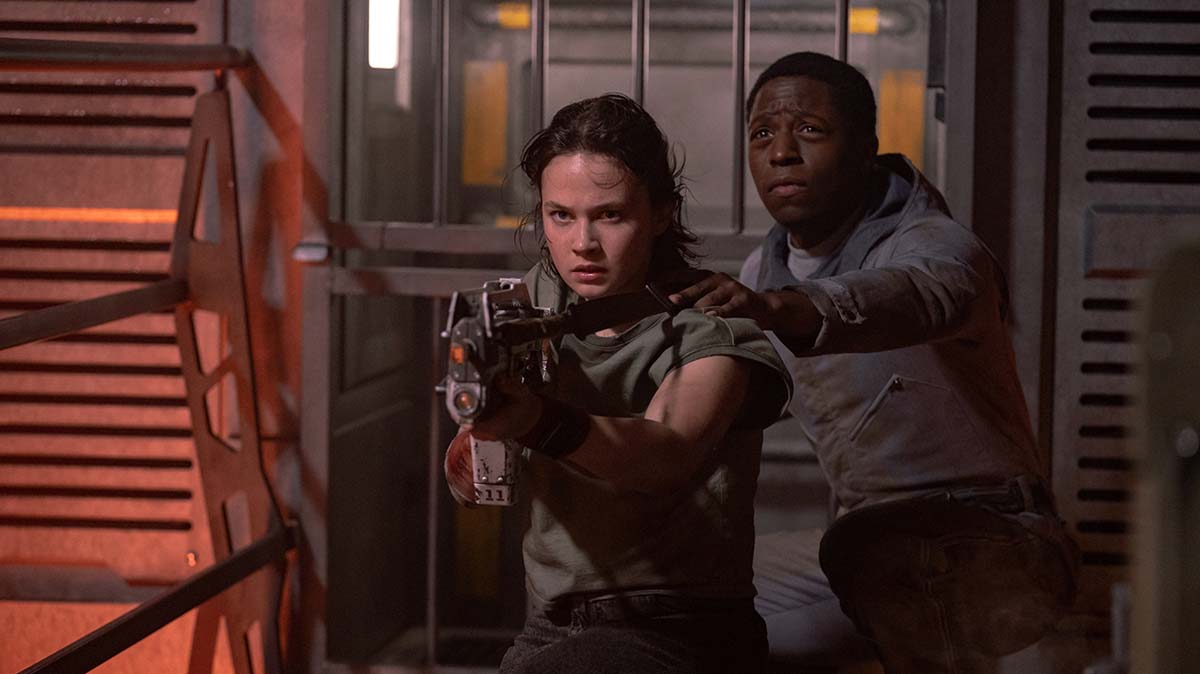
Did you add the graphic that said there’s zero hours of sunlight on the colony?
Yeah. Right. Things like that. And we changed a lot of the dialogue in the scene when she’s talking to the desk clerk person. That was a scene that was probably edited more than any scene in the film. It’s kinda mad! So often these slightly prosaic setup scenes are the things that get the most attention in the end. The big action sequences at the end kind of cut themselves. The things that feel really hard are actually quite easy and these tiny little building blocks that set up the world are the ones that you sweat and strain every frame to get the maximum mileage out of.
There’s a great deal of non-dialogue storytelling, which I loved at the beginning. Can you talk about the challenges of it, the difficulties of it, the great artistic freedom of telling a story without dialogue?
Absolutely. It’s actually one of my favorite things about the film. My favorite sequences in the film are all passages without dialogue. The space shots were ones that Fede and I were able to devise in the edit together because the script just says “probe passes through space” and that’s all you have to go on. Fede has a background in doing visual effects and so he would have his own system set up in the cutting room. The vast majority of shots in the film are either entirely practical or have a strong practical element within them.
Very few shots are a hundred percent CG but the obvious ones that are the big space exteriors. In those instances, Fede and I would cut the practical interior stuff and then we’d get to the bit where I’d just written on the screen “spaceship docks.” We could work out our outgoing, practical shot, then talk about what the speed should be, where the camera should be, and within 20 minutes he could create a gray scale shot, then we’d cut it into the Avid, then we could either decide, we need an extra shot or there was something wrong with that one and we could change it. So we were able to cut out what would’ve been two weeks of going back and forth with ILM trying to describe something because of Fede’s background in visual effects, which was a really unique and unusual experience that the director would be the first line of the visual effects team.

That made that a lot more collaborative and a lot more fun really just to cut that stuff. The opening sequence was one which we sort of built together in the Avid, apart from all the interior screens with the beeping of the probe. 99% of the time these days if you see a screen in a movie, it was shot blue screen and they just stick a screen in it. But in this film, almost without exception, all the screens were shot on the day except for when we re-timed something on the screen. But otherwise, mostly all of it was actually shot for real in terms of telling stories.
I think all filmmakers would say that doing non-dialogue scenes is the real cinema and that’s what everyone aspires to do if they can. As the story goes on, the premises become more and more complicated with regards to gravity purges and doors being locked or whatever it is. There’s a lot of complexity going on there and we were able to solve some of the problems by recontextualizing stuff that was shot to be something else and subtle digital alterations to make things work for us. Then we also did a couple of weeks of close-up pickups, but we did a lot of them in post. I don’t think Fede invented the process, but I’ve never seen it done where we literally would make our own plate in the edit suite. We’d find a chunk of the background of a scene which didn’t have anything in it, put it up on a screen in the edit suite, get Fede’s camera and shoot a pickup shot in the edit suite of someone’s hand pushing a button or something like that or closeups of the gun. Quite a lot of the ones that are in the film we shot in the edit suite just with the background being replaced like that. Even when we went to do pickups in Hungary where we actually got the cast back and did a proper pickup shoot, 90% of the ones that are in the film, we didn’t rebuild the sets four months later, we just stuck a digital still behind the actors which we’d taken from the edited footage and got them to just say their line in front of a projection essentially, which just made it a hell of a lot quicker.
So they’re able to shoot 20 pickup lines in one day across seven sets or nine sets or whatever. It was like a very, very low-fi version of The Volume (the LED virtual production stage where they shot The Mandalorian). So we were pulling out every trick in the book: both old-school and very 21st century solutions to allow us to not resort to lines of dialogue. You do always get the clarity notes from the studio saying, “We dunno what’s going on.”
As a geeky question, do you know what Fede was using when he was creating VFX on his laptop? What software? Blender? …or Unreal Engine?
Something “Max.” The whole space station and all the spaceship that the six kids are on were built fully 3D, so he had the assets.
Autodesk 3D Studio Max?
Could be that. It was a really fascinating way of working. It just made the whole thing a lot quicker. But we had all these stringent, self-imposed rules about not moving the camera in fake ways that you wouldn’t be able to do in an analog way. We didn’t do any sort of crazy digital zooms where you’re passing through the eye of a coffee cup handle or other impossible shots. Fede wanted every shot to look like a film camera in 1986 could have done it. Even things like: no object could pass too close to the camera lens where it would hit the matte box. Even when we were doing the zero gravity sequence with Rain in the elevator shaft he had to imagine that a cameraman could have shot the shot. There were some times where he would refuse to use a certain shot because he was the cameraman couldn’t possibly fit there, even thought no one in their right minds would ever notice. But at the same time it kind of seeps in. It was important for Fede and myself and the sound team as well as that we had in our own minds a kind of aesthetic we were trying to maintain. Ultimately you can feel it in the film whether, whether you know you why or what’s creating it.

The audience can feel the truth.
Hopefully. That goes to the practical creature effects and everything as well. We had tried to have rules like: we couldn’t have three digital “xenos” in a row. If you were giving the audience some sort of totally digital thing, then you kept having to check in with something that was real to constantly break up any kind of CGI artifice.
Talk to me a little bit about sound design and score. Did you use elements from the other movies? Or did you feel like it was a different world and therefore the sonic world needs to be different?
Fede wanted to use explicit elements of the original scores even if it was just a sort of palette of instruments or a tonal thing. In terms of the original temp, I limited myself to the previous six film scores to keep a coherence. We had a very good music editor [Clint Bennett] who came on board and did a much more complex temp even before [composer] Ben Wallfisch came in. We knew our composer was gonna be Benjamin Wallfisch from the beginning, but we didn’t really have any temps from him until late into the process. So we were originally using the old scores. When we briefed Ben, everything in the film was supposed to reference what came before, but also be completely new and ultimately something totally different. It goes somewhere none of the films have been before. There’s quite a lot of anvil strikes towards the end, when they’re on the space station referencing the Horner soundtrack.
Then, with the sound design, we had a great team Will [Files] and Lee [Gilmore] were involved really early. Fede even got them to create some sound design for the space ships, which he used on set to sort of blast quite loud for the actors ‘cause he wanted the actors to be projecting over the noise of what would be, ‘cause obviously the sound stages are really quiet so then actors tend to sort of whisper their lines and so he wanted a sense of everything’s gonna be very industrial and loud and booming so he would actually play the spaceship sounds and the corridor sounds on set to create the vibe but also just to kind of get a sense of the ambient noise.
Lee was brought in and watched the director’s cut and gave us some pretty evolved temp sound design for a lot the sequences early on. It lets you know which bits are really cool and so not to cut out too soon ‘cause we know they’ve got a great sound that goes with that, but also where you are lacking. It was good to have the back and forth with them. I was talking to Lee the other day and he was both sort of irritated and flattered that everyone assumes that they literally just took the sound effects from the original movies - like somewhere at 20th century there’s a vault of what the doors sound like. Or that’s what the beeps are. Actually none of that’s the case. He created every single thing from scratch and it’s all recreated bespoke for the film. So it was a huge amount of workand adding a whole bunch of stuff that that wasn’t there before. So it was a very involved process and then Fede wanted everything put through a tape simulator so that the pitch and the rhythm of the tape has a slight distortion to it. There’s a sort of imperfection to the whole soundtrack. A neurotic attention to detail, but it was evident all the way through.
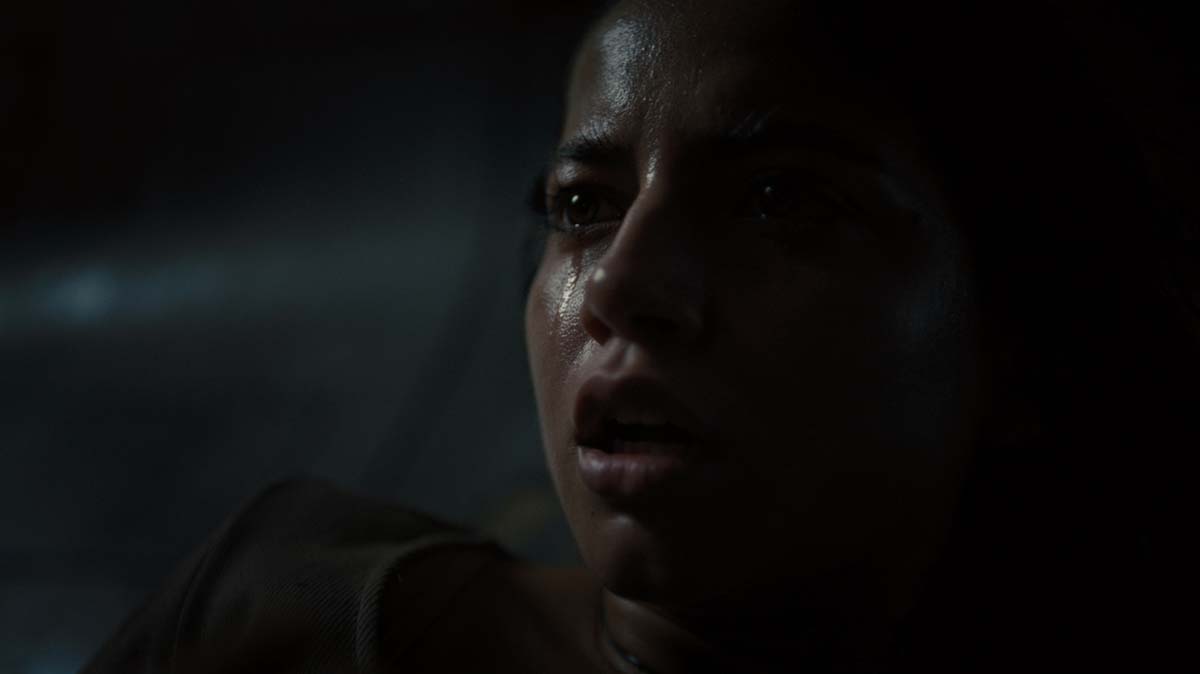
You kind of alluded to the fact at the beginning of the interview that this is a new genre for you. What do you do to generate suspense - the kind of horror suspense that was in this movie. What do you do to generate that editorially? There’s so much suspense in this movie where you’re just on the edge of your seat.
I hope that’s the case! The difficulty with all filmmaking is that you stop feeling it yourself pretty quickly and you’re going on gut instinct and the memory of the thousand films that scared you and it’s sort of different every time. But in simplistic terms, suspense is generally slow. You slow everything down just slightly slower than is comfortable. If a scene that’s just a sort of straight drama scene of two people having a conversation is kind of the speed that life actually happens at then if you want something to feel scary you actually distend everything a little bit and make all shots a little bit longer than it’s actually comfortable. Everything’s slower than what is normal movie speed.
Then action is the opposite. Everything’s faster than what is actually normal movie speed essentially. This film has a lot of both sides of that dial in it. Fede taught me quite a few things about the mechanics of jump scares. You want to sort of create an ambient state of maximum tension and then distract the audience from something that feels like a relief and then you hit them with the jump scare. It’s like a bait-and-switch. So if you don’t let them off the hook just before the jump scare, then they’re really waiting for it, then it’s not as good as if you just take it away and then hit them.
This goes for every genre or type of scene I’ve ever cut: it’s “horses for courses.” The material is shot a certain way and the images either sustain - and therefore you hold them and, and that’s great for an aesthetic reason or a tonal reason - and other times you need the next thing. You cut the next thing. And if it’s a complex action sequence with 20 angles, then you’re gonna be cutting every 18 frames. And if it’s a sort of a sustained horror beat where you’re going down a beautiful corridor that looks just like the original Alien movie with the steam, then you’re gonna hold that for 5, 6, 7 seconds and it’s just sort of interesting. I didn’t slavishly watch the other movies to kind of work out how to do it. You just kinda look at the material and judge it on that. It’s usually pretty evident from how a director’s shot a scene how it needs to be cut together.
One of the things that we talked about one of the last times we spoke was how edits change contextually. That you may cut a scene one way when you’re cutting it by itself: cutting scene 47 and you haven’t seen Scene 46 and scene 45. Then when you put them all together, now the context has changed. Is that something that happened in this movie?
I’ve been really spoiled ‘cause somehow it’s turned out that four films in a row I’ve done have been shot entirely in sequence

WHAT?!?
Yeah, Civil War was shot a hundred percent in sequence and this film was shot a hundred percent in sequence and Men was shot a hundred percent in sequence. There wasn’t really any of that at all. There was a very few occasions where for practical reasons they shot the interiors of the (spaceship that went up from the planet) in one big chunk, but other than that it was all shot in sequence. So that made that that aspect of it much easier because everything was in the sound stage. The actors were all there. The actors were young enough and they didn’t have superstar schedules where they were jetting off to go do another movie so they were all at Fede’s beck and call throughout. So we were able to do it the best way really. It allows you to learn what you’ve learned and because Fede was the writer/producer/director he was able to change certain things as he went based on what his instincts was. There were aspects that deviated quite a long way from what actually had been written.

You’ve edited with some of the biggest actors in the world and then you’ve got this very young unknown cast. Is there any difference in editing them, or they were just great actors and performance is performance?
There’s a bit of difference. I’m conscious of knowing that when you’re working with Jeff Bridges or Samuel L. Jackson or something, from the minute their face turns up on the screen, you’ve got just this wealth of goodwill. Everyone’s reassured. The audience says, “This is the guy! We’re in safe hands! I like him.” Their talent and their experience and the fact that they’re who they are because they can hold a screen incredibly well. But also just the audience’s memory of the 20 other amazing films they’ve made. But with a brand new cast you don’t have that. You’re at a standing start in terms of garnering that goodwill, so you have to work a little bit harder to make sure that you are playing to the sympathies of the audience - assuming that the intent is to get the audience on their side. And things like consistency. That’s more of an actor-to-actor thing. Some legends do it different every take and some legends do every take almost identical and the same goes for young actors as well. I don’t think that’s as much about experience so much as just styles of acting.
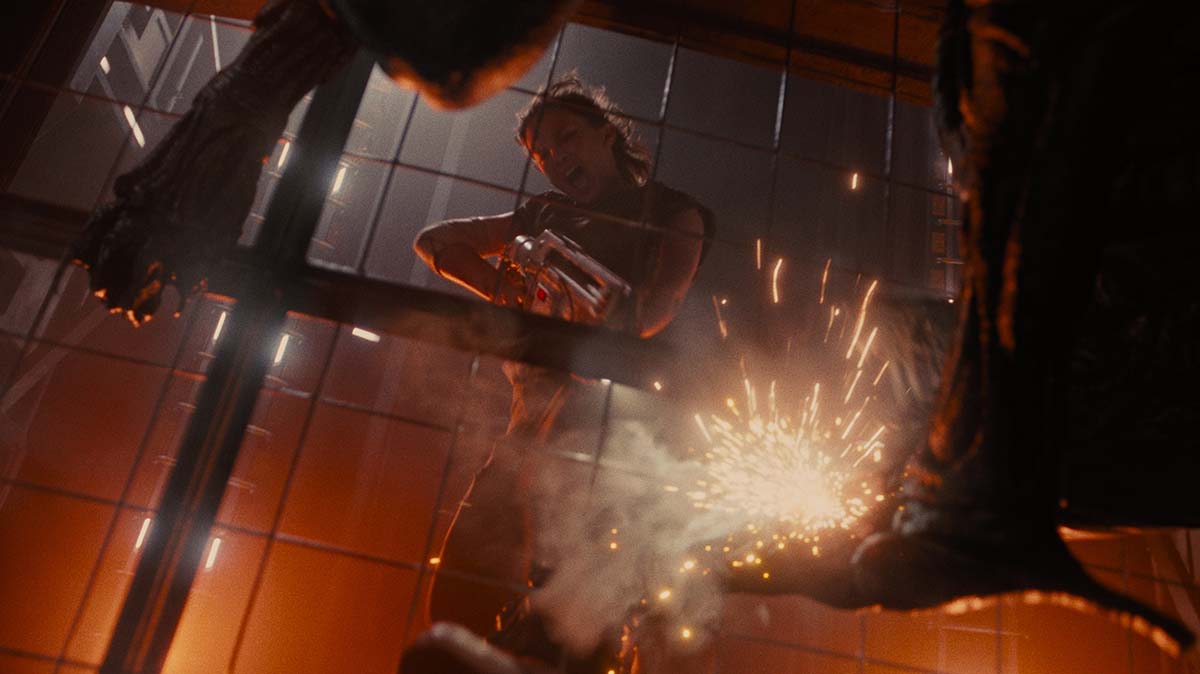
Was there any scene that you’re particularly proud of or that was more challenging than somebody might realize?
The hardest thing I think was the last 15 minutes because it is a huge chunk of time to have no dialogue at all. We tried our best to simplify. When it comes to the descriptions written on the page when it comes to non-dialogue action it’s rarely that representative of what they end up shooting, and no one ever updates the script for the benefit of the editor. The writer writes what they write, not knowing what the set looks like, not knowing what the proportions are, blah blah. So there’s a million ways in which these actions tend to change and the stunt coordinator gets involved and for any number of reasons certain things become obvious that they’re not physically possible. So I’m used to the fact that action deviates from what I’m expecting. But in this case it was just a huge chunk. There was very little to go on because once she was outside the ship, none of that stuff really existed. So they shot a bit of her hanging from a rope, but when we got to the end of the shoot, I wasn’t exactly clear how the movie was even meant to end.
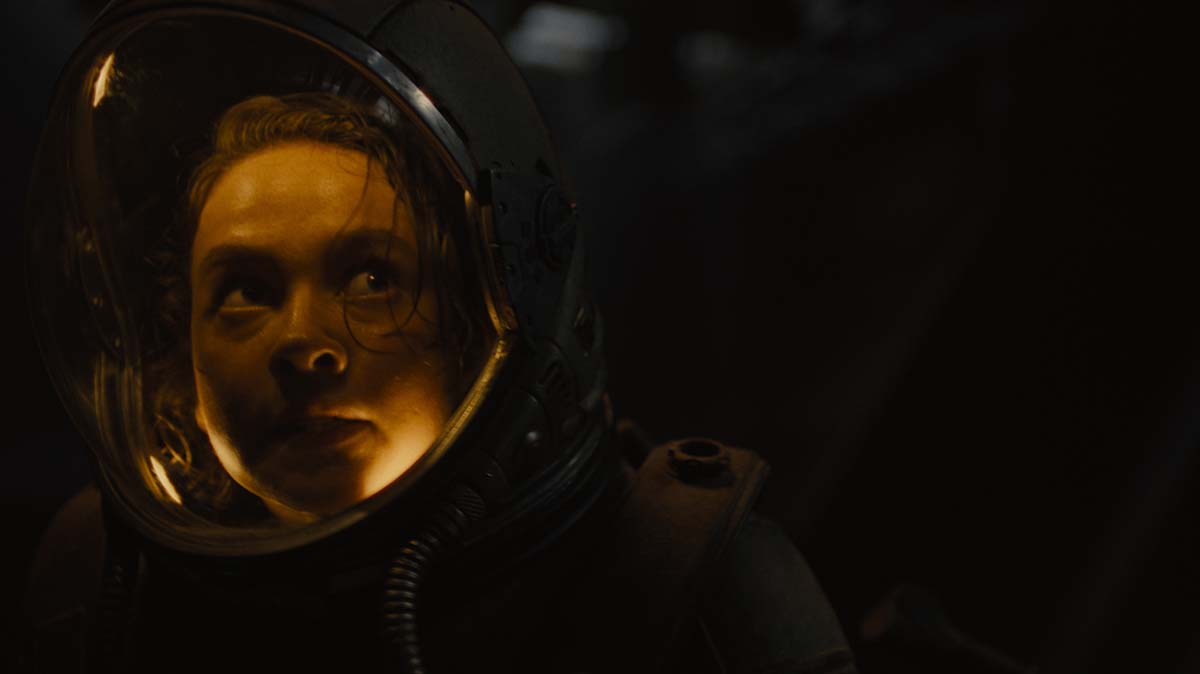
So in terms of simplifying and clarifying that story and hopefully making it compelling and and tracking what was going on, it was just a huge amount of work which kept going right up until the very end. The day we were meant to lock for the studio, we ended up re-conceiving the whole final sequence outside. The only element which really was truly in camera was Carlee’s performance in the helmet. All of her acting beats she’s acting to a completely different set of stimuli! The whole confrontation where the creature grabs her by the helmet and all that, we came up with on the last day! Fede did a very crude pre-vis because originally the creature was much further away and there was no actual contact. We had kind of done three stand-offs and we needed to have…
…An amping up of the conflict…
An amping up. Exactly. We’ve gotta go somewhere else we haven’t been. Also just to get a jump scare out of it was hard because she’s just floating on this rope, sort of dreamy and sort of low energy and almost trippy. It was fine, but we realized it should have a jolt of adrenaline rather than a kind of a toke on a joint, which is what it sort of felt like. The note kept coming back: “It’s just too long, it’s too long, it’s too long.”
Because of the way it was blocked, we knew we couldn’t put a jump scare in it because as soon as you did a time leap, you’d lose all the tension and you’d lose context of where she was ‘cause you’ve only got one character to follow. So there was nowhere to really cut to. So we had to stay with Rain’s character the entire time. There was a lot to do in the mechanics of it. We couldn’t really compress. So yeah, it was a challenge just to make it as lean as possible, but we realized that one of the ways in which people kept saying “make it quicker” and what we realized what they were saying is “we’re confused.” We couldn’t really make it that much quicker, but we tried to make it much clearer and by making it clearer, hopefully the sense that this is taking too long was sort of mediated. I’d say we worked most on that section than any other section of the film right up until the, the very, very, very end.
Also making it go from kind of a trippy ending to more action-packed - certainly even if it’s longer - would make it feel shorter.
Yes, exactly. And if you give them a sugar hit from a pure, cinematic standpoint, just the fact that there is almost no lines of dialogue at all for 15 minutes of the movie is kind of pleasing.
And pleasing to the audience. Jake, thank you so much for your time. It was really great talking to you about this movie. Congratulations.
Thanks. It’s a pleasure. I hope we get to do it again it’ll be zombies next.








